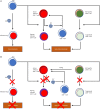Regulatory T Cells As Potential Targets for HIV Cure Research
- PMID: 29706961
- PMCID: PMC5908895
- DOI: 10.3389/fimmu.2018.00734
Regulatory T Cells As Potential Targets for HIV Cure Research
Abstract
T regulatory cells (Tregs) are a key component of the immune system, which maintain a delicate balance between overactive responses and immunosuppression. As such, Treg deficiencies are linked to autoimmune disorders and alter the immune control of pathogens. In HIV infection, Tregs play major roles, both beneficial and detrimental. They regulate the immune system such that inflammation and spread of virus through activated T cells is suppressed. However, suppression of immune activation also limits viral clearance and promotes reservoir formation. Tregs can be directly targeted by HIV, thereby harboring a fraction of the viral reservoir. The vital role of Tregs in the pathogenesis and control of HIV makes them a subject of interest for manipulation in the search of an HIV cure. Here, we discuss the origin and generation, homeostasis, and functions of Tregs, particularly their roles and effects in HIV infection. We also present various Treg manipulation strategies, including Treg depletion techniques and interventions that alter Treg function, which may be used in different cure strategies, to simultaneously boost HIV-specific immune responses and induce reactivation of the latent virus.
Keywords: FoxP3; cytotoxic T lymphocytes; human immunodeficiency virus; lymph node; regulatory T cells; simian immunodeficiency virus; virus eradication.
Figures

Similar articles
-
Nonhuman Primate Testing of the Impact of Different Regulatory T Cell Depletion Strategies on Reactivation and Clearance of Latent Simian Immunodeficiency Virus.J Virol. 2020 Sep 15;94(19):e00533-20. doi: 10.1128/JVI.00533-20. Print 2020 Sep 15. J Virol. 2020. PMID: 32669326 Free PMC article.
-
Severe depletion of CD4+ CD25+ regulatory T cells from the intestinal lamina propria but not peripheral blood or lymph nodes during acute simian immunodeficiency virus infection.J Virol. 2007 Dec;81(23):12748-57. doi: 10.1128/JVI.00841-07. Epub 2007 Sep 12. J Virol. 2007. PMID: 17855517 Free PMC article.
-
Cutting Edge: T Regulatory Cell Depletion Reactivates Latent Simian Immunodeficiency Virus (SIV) in Controller Macaques While Boosting SIV-Specific T Lymphocytes.J Immunol. 2016 Dec 15;197(12):4535-4539. doi: 10.4049/jimmunol.1601539. Epub 2016 Nov 11. J Immunol. 2016. PMID: 27837106 Free PMC article.
-
Regulatory T cells in retroviral infections.PLoS Pathog. 2018 Feb 15;14(2):e1006776. doi: 10.1371/journal.ppat.1006776. eCollection 2018 Feb. PLoS Pathog. 2018. PMID: 29447279 Free PMC article. Review.
-
Regulatory T cells in HIV infection: can immunotherapy regulate the regulator?Clin Dev Immunol. 2012;2012:908314. doi: 10.1155/2012/908314. Epub 2012 Oct 15. Clin Dev Immunol. 2012. PMID: 23251223 Free PMC article. Review.
Cited by
-
Spatial technologies to evaluate the HIV-1 reservoir and its microenvironment in the lymph node.mBio. 2024 Aug 14;15(8):e0190924. doi: 10.1128/mbio.01909-24. Epub 2024 Jul 26. mBio. 2024. PMID: 39058091 Free PMC article. Review.
-
Identification of prognostic and predictive biomarkers in high-dimensional data with PPLasso.BMC Bioinformatics. 2023 Jan 23;24(1):25. doi: 10.1186/s12859-023-05143-0. BMC Bioinformatics. 2023. PMID: 36690931 Free PMC article.
-
Plasmacytoid Dendritic Cells as Cell-Based Therapeutics: A Novel Immunotherapy to Treat Human Immunodeficiency Virus Infection?Front Cell Infect Microbiol. 2020 May 26;10:249. doi: 10.3389/fcimb.2020.00249. eCollection 2020. Front Cell Infect Microbiol. 2020. PMID: 32528903 Free PMC article. Review.
-
The Application Potential of the Regulation of Tregs Function by Irisin in the Prevention and Treatment of Immune-Related Diseases.Drug Des Devel Ther. 2024 Jul 16;18:3005-3023. doi: 10.2147/DDDT.S465713. eCollection 2024. Drug Des Devel Ther. 2024. PMID: 39050796 Free PMC article. Review.
-
Myeloid-derived suppressor cells and the pathogenesis of human immunodeficiency virus infection.Open Biol. 2021 Nov;11(11):210216. doi: 10.1098/rsob.210216. Epub 2021 Nov 10. Open Biol. 2021. PMID: 34753323 Free PMC article. Review.
References
-
- Sakaguchi S, Sakaguchi N, Asano M, Itoh M, Toda M. Immunologic self-tolerance maintained by activated T cells expressing IL-2 receptor alpha-chains (CD25). Breakdown of a single mechanism of self-tolerance causes various autoimmune diseases. J Immunol (1995) 155:1151–64. - PubMed
Publication types
MeSH terms
Grants and funding
LinkOut - more resources
Full Text Sources
Other Literature Sources
Medical
Research Materials

